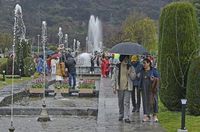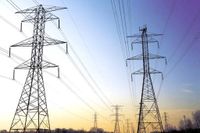Srinagar: With frequent rainfall and an improvement in weather conditions, hydropower generation in Jammu and Kashmir has surged by 44 percent over the past month. This increase comes after the Jammu and Kashmir Power Development Department (JKPDD) faced a staggering 84.17 percent decline in power generation, producing only 16 percent of its total capacity. A senior official from the Jammu and Kashmir Power Development Corporation (JKSPDC) recently announced a peak hydropower generation of 721 Megawatts (MW) from local plants.
According to the official, the power plants in the Kashmir region are currently generating 110 MW, while Jammu-based plants are contributing a peak generation of 611 MW. "At present, we are producing more than 60 percent of the total capacity, which is 1197.4 MW," the official stated. This marks a significant turnaround for the region, which had been heavily reliant on coal and solar energy due to a drastic drop in hydropower output.
Until the third week of February, Jammu and Kashmir was dependent on over 85 percent of coal and solar energy because of the severe decline in hydropower generation. Officials from the Power Development Department had previously indicated that local hydropower generation had plummeted by nearly 90 percent. One official had remarked, "Currently, Jammu and Kashmir is 85 to 90 percent dependent on coal and solar energy, which is procured from other states, as we do not have sufficient local generation." This reliance on external energy sources was exacerbated during winter, when hydropower generation from local plants dropped significantly.
In related weather news, fairly widespread light to moderate rain and thunderstorms have continued across Jammu and Kashmir over the past 24 hours, with the wet spell expected to persist until Friday, April 11, 2025. The Meteorological Department (MeT) predicts an improvement in weather conditions starting from the morning of April 12. The highest rainfall recorded during this period was in the ski resort of Gulmarg, where 5.4 mm of precipitation was measured.
As reported, Srinagar recorded 2.8 mm of rainfall, while the northern district of Kupwara received 5.3 mm and the southern resort of Pahalgam saw 4.2 mm. Due to the adverse weather conditions, authorities took precautionary measures by suspending vehicular movement on the Bandipora-Gurez road on April 10.
In terms of temperatures, the minimum night temperatures across Jammu and Kashmir have remained above normal, with most areas in the Kashmir division recording temperatures 2.4°C higher than usual, while the Jammu division experienced a rise of 4.6°C. Gulmarg recorded the lowest minimum temperature in Kashmir at 2.8°C, whereas Bhaderwah was the coldest in the Jammu region at 10.0°C. The maximum day temperatures also exceeded normal levels, with the Kashmir division showing an increase of 0.2°C and the Jammu division 2.7°C above normal.
The recent rainfall has notably raised the water levels in the river Jhelum—the lifeline of Kashmir. For the first time in six months, water levels at Ram Munshi Bagh reached 8.82 ft at 6:00 PM on April 10, while at Sangam and Asham, the levels were recorded at 5.11 ft and 5.68 ft respectively. Streams such as Vishow Nallah, Dachigam, Doodhganga, and Aru Nallah were also flowing above the Reduced Level (RL) of zero of gauge.
However, despite the recent wet weather, Jammu and Kashmir has faced a 50 percent deficit in rainfall from March 1 to April 9, 2025. Eleven out of twenty stations, including Srinagar, have reported a deficit precipitation ranging from 20% to 59% during this period. Although Pulwama and Bandipora have received average rainfall in the last 40 days, the winter capital and six other stations in the Jammu division have seen significant rainfall deficits between 60% to 99%.
With the forecast indicating a dry spell from April 12 to April 17, another moderate Western Disturbance is expected to affect Jammu and Kashmir starting April 18. This upcoming weather system could bring additional rainfall, potentially impacting hydropower generation once again.
As the region navigates these fluctuating weather patterns, the JKPDD remains hopeful about sustaining the recent increases in hydropower production. The officials are optimistic that with continued rainfall and improved conditions, the reliance on coal and solar energy will diminish, allowing Jammu and Kashmir to harness more of its renewable energy resources. With the rise in hydropower generation, the local energy landscape may see a significant shift, providing a more sustainable energy solution for the region.



